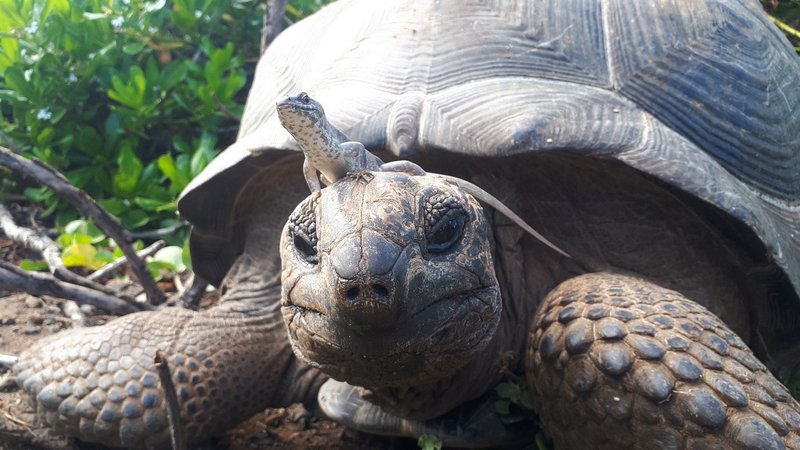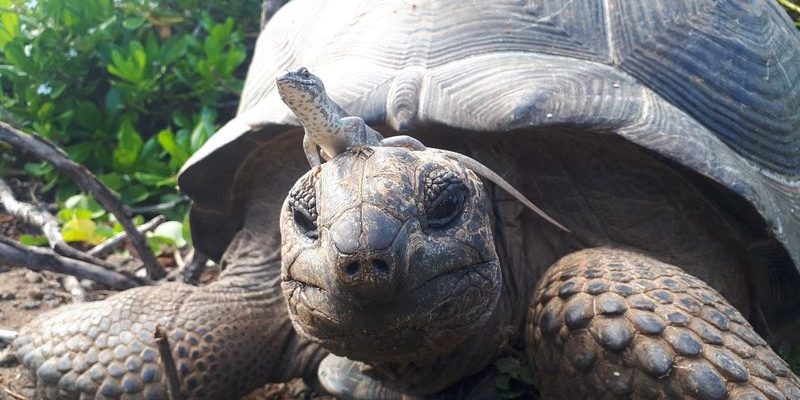
Aldabra giant tortoises are native to the Aldabra Atoll in the Seychelles, a group of stunning islands located in the warm waters of the Indian Ocean. This remote area is a paradise for wildlife and a vital habitat for these magnificent tortoises. But understanding their habitat and distribution is much more than just knowing the name of a few islands—it’s about how these tortoises interact with their environment and how they’ve adapted to survive. Let’s dive deeper into their world and explore the unique characteristics of their habitat.
The Aldabra Atoll: The Tortoise’s Home
The Aldabra Atoll is a UNESCO World Heritage Site and one of the largest raised coral atolls in the world. It’s made up of several large islands, with Aldabra Island itself being the most notable, and it spans about 34 square kilometers. Surrounded by a lagoon and coral reefs, this atoll is a sheltered haven for various marine life, including the Aldabra giant tortoises.
Here’s the thing: the atoll offers not just a home but a buffet of food! Aldabra giant tortoises primarily feed on grasses, leaves, and fruits, and the lush vegetation found on the islands provides them with plenty of sustenance. Because the atoll is relatively untouched by human activity, these tortoises can thrive in a natural environment that’s rich in nutrients.
However, the isolation of the Aldabra Atoll also means these tortoises have developed unique adaptations over millions of years. They have learned to endure dry seasons by storing fat in their bodies, allowing them to survive when water and food are scarce. It’s remarkable how nature crafts solutions to survive and flourish in specific environments.
Other Habitats and Distribution
While the Aldabra Atoll is the primary habitat of the Aldabra giant tortoise, these reptiles have been introduced to several other locations as well. For instance, conservation efforts have led to their relocation to some smaller islands in the Seychelles, like Curieuse Island. Here, they help maintain the ecosystem by grazing on vegetation and controlling plant growth, which is crucial for the balance of these fragile habitats.
It’s interesting to note that the Aldabra giant tortoise is distinct from other tortoise species, like the Galápagos tortoise. While both thrive on islands, their distribution and ecological roles differ. The Galápagos tortoise is spread across several islands in a different part of the world, each with its own unique adaptations.
When comparing their habitats, Aldabra Atoll offers a more stable climate with less fluctuation in temperature and humidity, making it an ideal home for these gentle giants. Understanding these differences can provide insight into how species adapt to their environments.
The Role of Climate in Their Habitat
Climate plays a significant role in shaping the habitat of the Aldabra giant tortoise. The atoll enjoys a tropical climate, which means warm temperatures year-round, but it also experiences wet and dry seasons. These conditions directly affect the availability of food and water sources for the tortoises.
During the wet season, rainfall can be abundant, and the vegetation flourishes. This is when tortoises can feast on fresh greens and fruits. But during the dry season, things can get tricky. Resources become scarce, and the tortoises must rely on their stored fat to survive. This incredible ability to endure tough conditions showcases their adaptability, but it also emphasizes the importance of a stable climate.
Changes in climate, such as rising sea levels and extreme weather patterns, pose threats to their habitat. If the atoll were to face significant changes, it could disrupt the delicate balance of their ecosystem and challenge these tortoises’ survival.
Conservation Efforts and Their Impact
The Aldabra giant tortoise is listed as *vulnerable* due to threats from habitat loss and invasive species. As a result, various conservation efforts have been put in place to protect these creatures and their habitat. Conservationists work hard to ensure that the Aldabra Atoll remains a safe haven for tortoises, focusing on preserving natural habitats and controlling invasive species that could threaten their survival.
One successful initiative has been the breeding programs on Curieuse Island. Here, tortoises bred in captivity are released back into their natural habitat, helping to bolster the population. These efforts not only help the tortoises but also contribute to the overall health of the ecosystem on the islands.
Moreover, raising awareness about the Aldabra giant tortoise and its habitat encourages sustainable tourism in the region. Tourists are drawn to the unique opportunities to see these majestic animals in their natural environment, which can fund conservation initiatives and promote eco-friendly practices.
Challenges Faced by Aldabra Giant Tortoises
Despite ongoing conservation efforts, the Aldabra giant tortoise faces several challenges that can impact their habitat and survival. One major concern is climate change, which can lead to unpredictable weather patterns or rising sea levels. If the atoll were to be submerged or experience severe weather, it could threaten the very existence of these tortoises.
In addition to climate issues, invasive species pose another threat. Animals like rats and cats can disrupt the delicate balance of the ecosystem, preying on tortoise eggs or competing for food. Conservationists are constantly working to manage these threats to ensure that tortoises can thrive without the risk of becoming overwhelmed.
Additionally, human activity, such as pollution and overfishing, can impact the health of the marine environment surrounding the atoll. Since Aldabra giant tortoises rely on a healthy ecosystem, these human-induced challenges underscore the importance of sustainable practices and conservation efforts.
The Future of Aldabra Giant Tortoises
The future of the Aldabra giant tortoise hangs in the balance, but with ongoing conservation efforts and global awareness, there’s hope. Initiatives focused on preserving their habitat and promoting eco-tourism are crucial. By educating the public about these tortoises and their unique role in the ecosystem, we can inspire conservation efforts beyond the Aldabra Atoll.
Let’s remember that these tortoises are not just fascinating creatures; they play a significant role in maintaining their habitat. By managing plant growth through their grazing habits, they help sustain the delicate balance of life on these islands.
Ultimately, the fate of the Aldabra giant tortoise is tied closely to the health of their environment. By understanding where they live and the challenges they face, we can work together to ensure that these gentle giants continue to thrive for generations to come.
In conclusion, Aldabra giant tortoises are a treasure of biodiversity, uniquely shaped by their habitat on the Aldabra Atoll. Through conservation efforts and awareness, we can protect not only these remarkable creatures but the rich ecosystems they inhabit. It’s a journey that requires collective responsibility and appreciation for nature, one that can lead to a brighter future for all wildlife.

